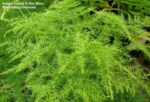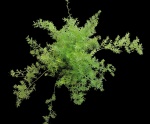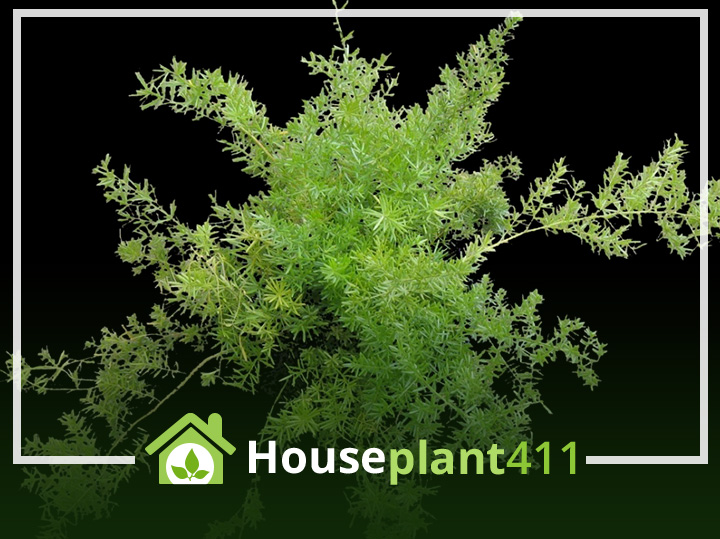About an Asparagus Fern
An asparagus fern (Asparagus aethiopicus) is not a true fern at all but rather a member of the Lily family and a close relative of such plants as the tulip, amaryllis, and hosta. The name asparagus fern comes from the fact that the new growth on these plants resembles tiny asparagus spears. Originally found growing in South Africa, it’s now quite prevalent in subtropical areas in many countries. As asparagus fern is easier to grow than “true” ferns such as the Boston Fern, Kimberly Queen Fern, or the Maidenhair Fern. During the summer, this is a perfect plant to hang outside in a bright spot on your porch. Just be careful, too much sun or very high temperatures may cause yellow foliage, leaf drop, or brown edges on the “leaflets.”
Description
An asparagus fern has long stems of graceful, feathery, bright green foliage. The tiny “leaves” are not really leaves at all; they are flattened, short, needlelike, modified stems. The plant looks best in a hanging basket so the arching, trailing stems can grow freely. An asparagus fern produces small white flowers and bright red berries. As the plant matures, stems become a little woody and develop sharp spines. Some asparagus fern varieties, like the springeri, grow over 2-3ft. wide with cascading trailing stems 2ft-4ft.in length.
Asparagus Fern Varieties
Asparagus plants are excellent houseplants because they easily adapt to different light levels, temperatures, humidity. Here are are few of the most popular varieties:
Asparagus sprengeri, a cultivar of Asparagus densiflorus, has long, arching stems and tiny needle-like, bright green “leaves;” an added plus are the small white flowers that eventually turn into red berries. Be careful, hidden in the lush foliage of an asparagus sprengeri are sharp little thorns that are difficult to see.
Asparagus plumosa (Asparagus plumosus) is a compact plant with delicate, spreading, horizontal branches covered in feathery “leaves;”
Foxtail Fern (Asparagus Meyeri) has long, bushy fronds that really do resemble a fox’s tail.



A. plumosa A. Sprengeri A. Foxtail
Asparagus Fern Problems
Plant dies: usually caused by root rot due to over watering
Foliage turns yellow: usually caused by over watering, too much plant food, very, very dry air, spider mites
Quick Care Tips
Moderately warm temperatures above 55°F (28°C) and below 75°F (23.9°C)
Avoid direct sunlight
Water less in winter and water from the bottom to prevent over watering
Avoid placing the plant near a fireplace, heater, and cold drafts in winter
Plant is easily propagated any time of the years by dividing the root ball
Is an Asparagus Fern Poisonous
An asparagus fern is a poisonous plant and toxic to cats, dogs, and other pets. Please keep it away from small children who are often attracted by the bright red berries the plant produces. Read more about common houseplants that can be dangerous in my book Don’t Feed Me to Your Cat: A Guide to Poisonous Houseplants.
Plant Care
Light
How much light for an Asparagus Fern: These plants grow best in bright indirect light coming from an east, west, or north-facing window. In lower light an asparagus fern grows very slowly and may develop yellow fronds.
Water
How to water an Asparagus Fern: Do not water until the top 50% of the soil has dried out. If in doubt, allow the fronds to turn pale green before watering. An asparagus fern requires more water in the hot summer months, and likes drier soil during the cold winter months. Asparagus ferns are very drought resistant; however, yellow stems indicate the plant needs more water while brown stems mean you may be over- watering your asparagus fern.
Fertilizer
How to fertilize an Asparagus Fern: Feed weekly during the summer with a water-soluble, balanced plant food. Feed monthly during the rest of the year. Always dilute the fertilizer to 1/2 the recommended strength.
Temperature
Best temperature for an Asparagus Fern: Temperature should be between 50°-75°F (10°-24°C). These plants can even survive briefly in temperatures as low as 36°F (2.2°C).
Humidity
Does an Asparagus Fern need high humidity: Since this plant is not really a fern at all, but really a member of the lily family, it does well in normal to low humidity.
Flowering
Does an Asparagus Fern flower: The plant produces small white flowers, nestled amongst small thorns, that turn into poisonous red berries.
Pests
Asparagus Fern plant pests: Mealy bugs, spider mites, aphids, scale and thrip are common pest probems. An asparagus fern can be damaged by commercial pesticides; use a mild solution of insecticidal soap to treat plant pests.
Diseases
Asparagus Fern plant diseases: Root rot, botrytis, rust, powdery mildew can be a problem. Read more about how to identify and treat these diseases in the Glossary of the website.
Soil
What kind of soil for an Asparagus Fern: Use a well- aerated potting soil that drains quickly. If the soil seems too heavy or clay-like and is not draining well, add some sand, perlite, or peat moss.
Pot Size
How big a pot for an Asparagus fern: Being kept root-bound in a small pot, encourages the graceful stems to grow even longer.
Pruning
How to prune an Asparagus Fern: Quickly remove leaves or stems that turn yellow due to intense heat or light. Prune damaged stems as close to the soil surface as possible.
Propagation
How to propagate an Asparagus Fern: Plant division, or more specifically tuber division, is the easiest propagation method. The best time of the year to propagate an asparagus fern is in the spring before it starts producing new growth. The root ball full of tubers is often difficult to divide, so have plenty of strong, sharp, clean tools available. Read more about propagating plants by plant division in the Glossary of the website.
Resting Period
An asparagus fern, like many tropical plants, rests during the cooler months. In winter, when the plant is dormant, it requires less water..
Poisonous Plant Info
An Asparagus Fern is considered a poisonous plant and should be kept away small children , cats, dogs, and birds. Although the leaves are not harmful, the sharp, small thorns can be painful if touched and the red berries are toxic and cause digestive problems if eaten.
FAQ
Congratulations, berries & flowers develop when an asparagus fern is getting all that it needs. The flowers and berries of an Asparagus Fern won’t hurt the plant, but may slow down the development of new leaves. Please remember the red berries of an Asparagus Fern are poisonous and will cause digestive problems if eaten.
An Asparagus fern gets yellow straw-like vines when the soil has gotten too dry. Cut off the dead vines as close to the soil as possible and water water your asparagus fern really well. Never fertilize a plant when the soil is very dry.
I have my asparagus fern in my bedroom across from a north- facing window. What I want to know is why it isn’t it growing? Your asparagus fern needs a great deal of very bright light to grow well. Try moving it directly in front of a north facing window or better yet to a western or eastern exposure.
An asparagus fern tells you when it needs a new pot. When the the root ball gets too big, the roots are so strong they break the growers pot or start forcing the soil up over the edge of the pot. If this isn’t happening and you still think your fern needs a larger pot, gently pull the fern out of its pot. If the roots have filled the pot and there is very little soil left, it’s time for a new container.

